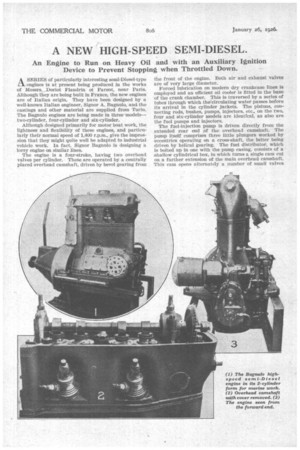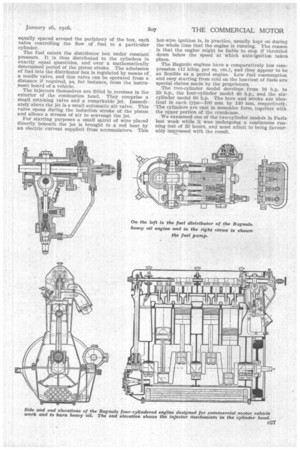A NEW HIGH-SPEED SEMI-DIESEL.
Page 10

Page 11

If you've noticed an error in this article please click here to report it so we can fix it.
An Engine to Run on Heavy Oil and with an Auxiliary Ignition Device to Prevent Stopping when Throttled Down.
A SERIES of particularly interesting semi-Diesel-type engines is at present being produced in the works of Messrs. Doriot Flandrin et Parent, near Paris. Although they are being built in prance, the new engines are of Italian origin. They have been designed by a well-known Italian engineer, Signor A. Bagnulo, and the castings and other material are supplied from Turin. The Bagnulo engines are being made in three. modelstwo-cylinder, four-cylinder and six-cylinder.
Although designed primarily for motor boat work, the lightness and flexibility of these engines, and particularly their normal speed of 1,400 r.p.m., give the impression that they might quite well be adapted to industrial vehicle work. In fact, Signor Bagnulo is designing a lorry engine on similar lines.
The engine is a four-stroke, having two overhead valves per cylinder. TheSe are operated by a centrally placed overhead camshaft, driven by bevel gearing from the front of the engine. Both air and exhaust valves are of very large diameter.
Forced lubrication on modern dry crankcase lines is employed and an efficient oil cooler is fitted in the base of the crank chamber. This is traversed by a series of tubes through which the circulating water passes before its arrival in the cylinder jackets. The pistons, connecting rods, bushes, pumps, injectors, etc., on the two, four and six-cylinder models are identical, as also are the fuel pumps and injectors.
The fuel-injection pump is driven directly from the extended rear end of the overhead camshaft. The pump itself comprises three little plungers worked by eccentrics operating on a cross-shaft, the latter being driven by helical gearing. The fuel distributor, which Is bolted up in one with the pump casing, consists of a shallow cylindrical box, in which turns a single cam cut on a further extension of the main overhead camshaft. This cam opens alternately a number of small valves equally spaced around the periphery of the box, each valve controlling the flow of fuel to a particular cylinder.
The fuel enters the distributor box under constant pressure. It is thus distributed to the cylinders in exactly equal quantities, and over a mathematically determined period of the piston stroke. The admission of fuel into the distributor box is regulated by means of a needle valve, and this valve can be operated from a distance if required, as, for instance, from the instrument board of a vehicle.
The injectors themselves are fitted in recesses in the exterior of the combustion head. They comprise a small retaining valve and a remarkable jet. Immediately above the jet is a small automatic air valve. This valve opens during the induction stroke of the piston and allows a stream of air to scavenge the jet.
For starting purposes a small spiral of wire placed directly beneath the jet is brought to a red heat by an electric current supplied from accumulators. This hot-wire ignition is, in practice, usually kept on during the whole time that the engine is running. The reason is that the engine might be liable to stop if throttled down below the speed at which auto-ignition takes place.
The Bagnulo engines have a comparatively low compression (12 kilog. per sq. cm.), and they appear td be as flexible as a petrol engine. Low fuel consumption and easy starting from cold on the heaviest of fuels are special claims made by the proprietors.
The two-cylinder model develops from 16 h.p. to 20 h.p., the four-cylinder model 40 h.p., and the sixcylinder model 60 h.p. The bore and stroke are identical in each type-100 mm. by 140 mm. respectivelY. The cylinders are east in monobloc form, together with the upper portion of the crankcase.
We examined one of the two-cylinder models in Paris last week while it was undergoing a continuous running test of 50 hours, and must admit to being favourably impressed with the result.




























